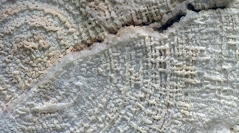

 Comptes Rendus Palevol
20 (31) - Pages 641-666
Comptes Rendus Palevol
20 (31) - Pages 641-666A rich poriferan assemblage was identified within the easternmost part of the Getic Carbonate Platform of Romania (Grădiștei Gorges). The excellent preservation state of most poriferans here led to the discovery of a new species (Neuropora gigantea Pleș & Schlagintweit, n. sp.) and to the identification of previously unknown diagnostic features in some species (Sarsteinia babai Schlagintweit & Gawlick, 2006 emend., Neuropora lusitanica Termier, 1985, Sphaeractinia steinmanni Canavari, 1893). Calciagglutispongia yabei Reitner, 1992, Sarsteinia babai and Sphaeractinia steinmanni are reported for the first time from the Upper Jurassic carbonates of the Getic Carbonate Platform. The sedimentary input fluctuations and the nutrient competition had an important role in understanding the morphological adaptations of the analysed species. The existing palaeoecological and palaeoenvironmental conditions generated different distribution patterns towards the reef profile and also preferential adaptations to a specific Tethyan domain. As opposed to the poriferan assemblages from the northern Tethyan shelves, these organisms formed sponge-coral-microencruster boundstones at the margins and fore-reefal zones of isolated carbonate platforms within the intra-Tethyan realm. The importance of calcified sponges in reef-zonation is highlighted by the establishment of a general zonation model. Three zones can be distinguished: 1) Cladocoropsis-Milleporidium zone (back-reef area); 2) Bauneia-Chaetetopsis-Parastromatopora zone (central reef area); and 3) Sphaeractinia/Ellipsactinia-Neuropora zone for the fore-reef area. In the absence of a true reef framework these calcified sponges developed typical morphologies, environmental adaptations and partnerships with other biotic groups which strongly influenced the carbonate production throughout the intra-Tethyan domain.
Calcified sponges, microencrusters, carbonate platforms, Intra-Tethyan realm, reef zonation, palaeoenvironments, palaeoecology, taphonomy, Kimmeridgian-Tithonian, new species